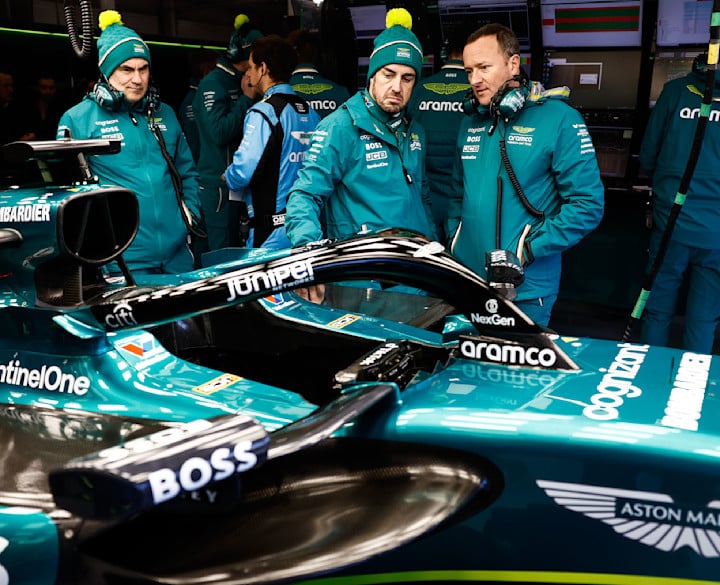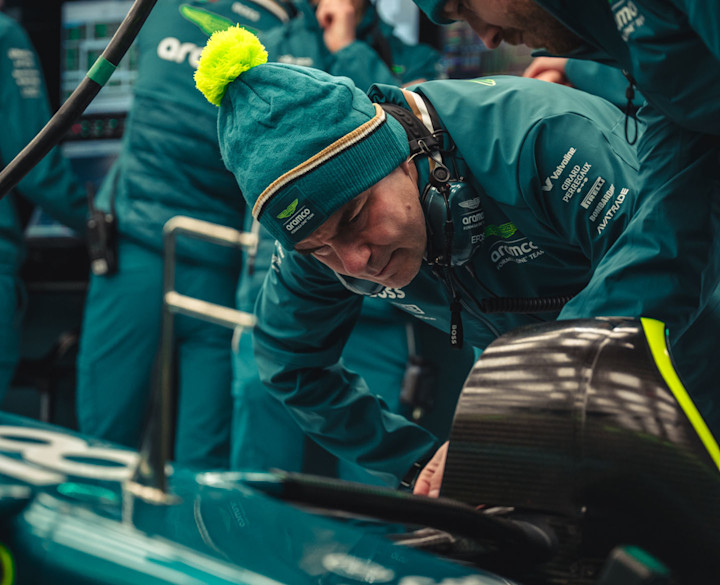
Technical Director Dan Fallows lifts the lid on our 2024 Formula One challenger, the lessons learnt from last year, and why this season promises to be even more competitive than the last.
Debuting a new F1 car is always a tense time for any team – exciting, but tense. The product of months of hard work and dedication revealed to the world; its first foray on track a voyage into something of the unknown – with no amount of advanced simulation and modelling a substitute for pushing the car to its limits on the racetrack.
Focused on taking the next step, our technical team has refined and improved almost every area of our 2024 challenger. Lighter, more aerodynamically efficient and more versatile, AMR24 has been designed to build on the strengths of its predecessor and apply the learnings from our most successful season to date.
The design philosophy hasn't changed, but almost every part has in the pursuit of progress. During the furore of our season launch, we caught up with Technical Director Dan Fallows to discover more.
AMR24 has broken cover. What's new on our 2024 challenger?
The chassis, nose, front wing, floor, and front and rear suspension are all new. None of the surfaces are the same as AMR23 apart from those where the design is prescribed by the regulations. Pretty much everything has changed.
We've changed the front wing so it does a better job of managing the wake from the front wheels. The bodywork has changed to manage the flow of air around the floor better and to control it more as it goes towards the rear wing. The floor has also changed because that's the biggest area of downforce generation – it's constantly evolving.
We now have a push-rod suspension layout at the rear. The front suspension has been altered to work better alongside the front wing and floor, and the rear suspension has changed to accommodate the latest power unit and gearbox assembly from Mercedes.
AMR24 is a strong and exciting evolution of last year's car. We've taken the lessons that we learnt, particularly in the last part of the 2023 season, to develop a car with a wider operating window and that will provide a strong platform for development over the course of this year.

From the end of AMR23 to AMR24 we've hit our target for development, and we've made a step. We feel we're in a much better place this year with the car for in-season development.
Have we hit our targets with AMR24 over the winter?
Last year, rather than having a linear development slope over the season, it went a bit up and down, but we finished the season with a car that was a good reference point.
From the end of AMR23 to AMR24 we've hit our target for development, and we've made a step with the car. Our competitors will have also made a step over the winter, so it's all relative, but we feel we're in a much better place this year with the car for in-season development.
What have we learnt from last year's car?
We used the end of the 2023 season as a bit of an R&D exercise, to try to gain a much better understanding of what the car was doing and where we may have made some mistakes with our mid-season development.
At the start of last season, we felt that we were weak in high-speed corners so we put a lot of effort into putting downforce on the car for high-speed corners, but ultimately that didn't make the car much faster because we ended up narrowing the operating window.
We learnt a lot, but we also brought some of the development for this year's car forward to last year, namely the floor.
Why is it such a challenge to make a car perform well at all circuits and types of corners?
With the current regulations, we have these very large floors which generate downforce from ground effect and they operate much better when they are closer to the track. However, racing cars don’t work very well if they're very stiffly sprung and absolutely fixed in one position relative to the ground. You're therefore trying to make the car move around enough so that you have good kerb-riding, good traction, but also produce downforce in all those conditions.
You have to decide whether you maximise your downforce in a very small ride height window, or whether you broaden that ride height window to enable the car to perform better mechanically at more circuits and more corner types, but not maximise the downforce.

We're now seeing a situation where a couple of tenths is worth five or six positions in Q3. It's going to be harder and harder for teams to regularly make it into Q3 and score points.
The AMR24 is the first Aston Martin Formula One car to be designed and built in the new AMR Technology Campus. How important has that been?
The new AMR Technology Campus is a hugely positive step for our development as a team. The difference it's made is night and day: in terms of communication, collaboration and ways of working.
It sounds like such a simple thing but just having everyone in the same location, sitting next to one another makes such a big difference. The way the technical groups are working together has really improved as a result. It's enabling a far more joined-up way of thinking and working and that's only going to yield better results.
You've mentioned how you want AMR24 to provide a strong platform for in-season development. What does the update programme look like for AMR24?
We want to give ourselves the best chance of bringing updates to the car that perform right away. That involves not just doing your homework before an update makes it to the track, but also making sure you've got proper comparisons on the track.
When we updated both cars for the Canadian Grand Prix last year, we were relying on our deltas at previous races. Whereas if you go to a circuit with one car in one spec and the other in a different spec, it gives you a chance to do a good back-to-back comparison.
We were very aggressive with our update programme last year. For example, we brought new floors to the Sprint weekend in Austin, but this year we are going to be a bit more cautious about sending significant updates to Sprint weekends where we can potentially cause ourselves confusion.
The culmination of countless hours of work and uncompromising craft, our 2024 Formula One car builds on the strengths of its predecessor and applies the learnings from our most successful season to date.

What can we expect from the 2024 Formula One season?
From a performance point of view, every team is converging on a similar car concept, so the field is closing up and also getting closer to Red Bull. We're now seeing a situation where a couple of tenths is worth five or six positions in Q3. It's going to be harder and harder for teams to regularly make it into Q3 and score points.
The slightest performance advantage or step forward with an update could make all the difference and driver performance will have an even greater bearing on results.
2023 was an intense year for everyone in the team and the 2024 campaign consists of a record-breaking 24 Grands Prix. Is everyone ready for the season ahead?
There were some tired people here as we went into the winter shutdown. As you can imagine, it was a full-on end to the season with so many flyaways, double-headers and triple-headers, and we were working around the clock to finish the season strongly.
The podium in Brazil really helped. We learnt a lot from the updates we brought to Brazil, and getting the podium there was a massive motivator going into the winter.
There's a lot of positive energy flowing through the AMR Technology Campus, and everybody is pushing hard to build on last year. We're refreshed, rejuvenated, and focused.
We're ready for the next chapter of our journey.
I / AM membership
The ultimate fan experience.
Get closer to the team with unparalleled access, behind-the-scenes insights and once-in-a-lifetime experiences, and enjoy exclusive competitions, rewards, offers and more.







































